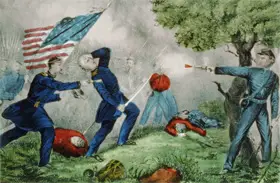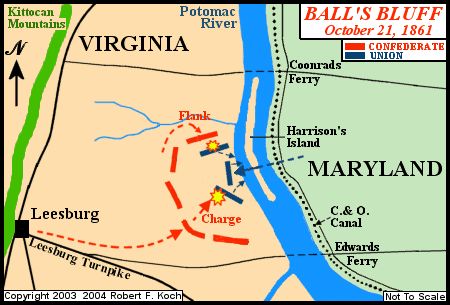Civil War Battles |
Colonial Wars |
American Wars |
Link To This Page — Contact Us —
The Battle of Ball's Bluff
October 21, 1861 in Ball's Bluff, Virginia
 |
|||||||||||||||||||||
|
The Battle of Ball's Bluff, also known as the Battle of Harrison’s Landing or the Battle of Leesburg, took place in Loudoun County, Virginia, as part of Maj. Gen. George B. McClellan's operations in northern Virginia. It was the second largest battle of the Eastern Theater in 1861.
McClellan had recently been promoted to General-in-Chief of all Union armies and felt pressure from the Lincoln administration to take offensive military action. He chose to launch a reconnaissance in force in hopes of seizing Potomac River crossing sites and, ultimately, Leesburg.
Though the Union commanders seem to have discussed various options for forward movements across the Potomac River during the weeks preceding Ball's Bluff, the battle as actually fought there was unintended and unplanned.
On October 19, McClellan ordered Brig. Gen. George A. McCall to march his division to Dranesville, 14 miles south of Leesburg, hoping to intimidate Brig. Gen. Nathan "Shanks" Evans into abandoning Leesburg. Evans did move out of the city, taking up a defensive position on the Leesburg Turnpike. McCall's orders were to leave the area that night. Meanwhile, McClellan was uncertain Evans had actually evacuated, and ordered Brig. Gen. Charles P. Stone to stage a demonstration at Edwards' Ferry to distract the Confederates and glean positions and intentions. Stone personally supervised the crossing at Edwards' Ferry; he also decided on a second demonstration 2 miles upriver, and he delegated that task to one of his brigade commanders Col. Edward D. Baker, a sitting senator in the U.S. Congress at the time.
Stone sent a small reconnaissance patrol out to Ball's Bluff on the evening of October 20. The patrol found what it thought was an undefended Confederate camp, rows of Confederate tents in the fields behind Ball's Bluff, and reported this to Stone. He then ordered a larger force to cross over and raid the camp.
 |
Early on the morning of October 21, Col. Charles Devens and his 300-man raiding party from the 15th Massachusetts discovered that in the dark, the patrol was mistaken, the "tents" were merely moonlit reflections from rows of trees. There was not any Confederate camp to raid, so Devens sent word back to Stone and stayed on the southern bank of the river awaiting further orders.
Stone's written instructions to Baker ordered that additional forces under Baker's command be crossed to the Virginia side, or completely withdrawn at Baker's discretion, depending on the situation. Instead of crossing to the bluff personally to evaluate his tactical options, he immediately chose to cross his entire force, and for some hours, personally supervised the lifting of boats from the nearby Chesapeake & Ohio Canal to assist his river crossing. In short, the small patrol became a raiding party that then became a larger patrol. While waiting to hear from Stone, Devens was surprised by Confederate pickets from the 17th Mississippi and engaged them in a short firefight - but neither Stone nor Baker knew until later that the Confederates were reacting.
Baker heard of the fight while on his way to Ball's Bluff. He immediately began ordering more troops over but did so without evaluating the situation or going over himself to study the ground. Finding that there were not enough boats to efficiently cross a large number of troops, he then spent considerable time personally supervising the search for more, a job he should have assigned to a staff officer. The shortage of boats became a significant problem for the Union forces as the crossing point itself became a deadly choke point.
After the initial skirmish, both sides gradually reinforced. Other skirmishes followed around 11:30 A.M. and 12:30 P.M. with lulls in between. The climactic action began around 2:30 P.M., by which time most of the troops had arrived on the field. It lasted until after dark. The Federals were positioned near the current national cemetery, many of them placed by Baker in the open facing across a large clearing with their backs to the bluff and the river. The Confederates gradually completed a horseshoe-shaped encirclement of the Union position.
Shortly after the action became general, Baker, passing in front of his command, was killed by a sharpshooter. This demoralized the Federals that the surviving officers conferred and decided to retreat. Panic took hold and the Federals fled in confusion down the bluff. In the precipitate retreat of the enemy on the bluffs of the river, many of his troops rushed into the water and were drowned, while many others, in overloading the boats, sunk them and shared the same fate. Many drowned or were shot attempting to swim the river.
Boats attempting to cross back to Harrison Island were soon swamped and capsized; a disturbing number of the casualties resulted from drowning and dead bodies floated as far downriver as Washington, D.C. in the days following the battle. More than 500 Union prisoners were captured on the banks of the Potomac later that night.
This Union rout was relatively minor in comparison to the battles to come in the war, but it had an enormous impact. Due to the loss of a sitting senator, it had severe political ramifications in Washington. The blame fell on Stone, who was was treated as the scapegoat for the defeat. He was arrested on February 9, 1862 on charges that insinuated treason and was imprisoned in Fort Lafayette and Hamilton in New York for 189 days without trial.
Members of Congress suspected that there was a conspiracy afoot to betray the Union. The outcry led directly to the establishment of the "Congressional Joint Committee on the Conduct of the War," which would bedevil Union officers for the remainder of the war and contribute to nasty political infighting among the generals in the high command. This shabby treatment by Lincoln and his new Secretary-of-War, Edwin M. Stanton, came at the urging of the committee and other Radicals who needed a scapegoat and who considered Stone "unsound on the question of slavery."
